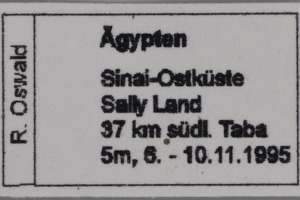Inhalt
2. Diagnose
2.1. Weibchen
1-3: ♀, ssp. aegyptiaca (Wiltshire, 1947): Ägypten, Daten siehe Etikett (fot.: Michel Kettner), coll. ZSM
2.2. Erstbeschreibung
1-6: Turati (1924: 84-86, pl. III figs. 21-22) [Reproduktion aus Band in der Bibliothek des Museums Koenig, Bonn: Jürgen Rodeland]
4. Weitere Informationen
4.1. Synonyme
- Antitype glaisi Lucas, 1932
4.2. Andere Kombinationen
- Pseudopolia aurora Turati, 1924 [Originalkombination]
4.3. Unterarten
- Polymixis aurora commixta (Rungs, 1942)
- Polymixis aurora aegyptiaca (Wiltshire, 1947)
4.4. Faunistik
Falck & Karsholt (2022: 152) melden die Art erstmals von Fuerteventura (Kanarische Inseln) und damit aus Europa i.w.S.: "Material examined: SPAIN, FUERTEVENTURA, Corralejo, 10 m, 13 ♂♂, 7-27-XI-2017, leg. P. Falck (PF). New to the Canary Islands. [...] Remarks: The specimens from Fuerteventura belong to P. aurora commixta (Rungs, 1943). It is probably a migrant from Africa." Als Gesamtverbreitung geben jene Autoren an: "Distribution: North Africa from Morocco to Egypt (FREINA & BEHOUNEK, 1996: 29)."
(Autor: Erwin Rennwald)
4.5. Literatur
- Falck, P. & O. Karsholt (2022): New data on Noctuoidea from the Canary Islands, Spain (Lepidoptera: Noctuoidea). — SHILAP Revista de Lepidopterología 50 (197): 145-165. [PDF auf researchgate.net]
- Erstbeschreibung: Turati, E. (1924): Spedizione lepidotterologica in Cirenaica 1921 - 1922. — Atti della Società Italiana di Scienze Naturali 63: 21-191, pl. I-VI. Pavia.




![Vorkommen auf den Kanarischen Inseln [Falck & Karsholt (2022)]](/res/img/flag/es-cn.png)
![Vorkommen in Ägypten (asiatischer Teil) [Foto]](/res/img/flag/eg.gif)












